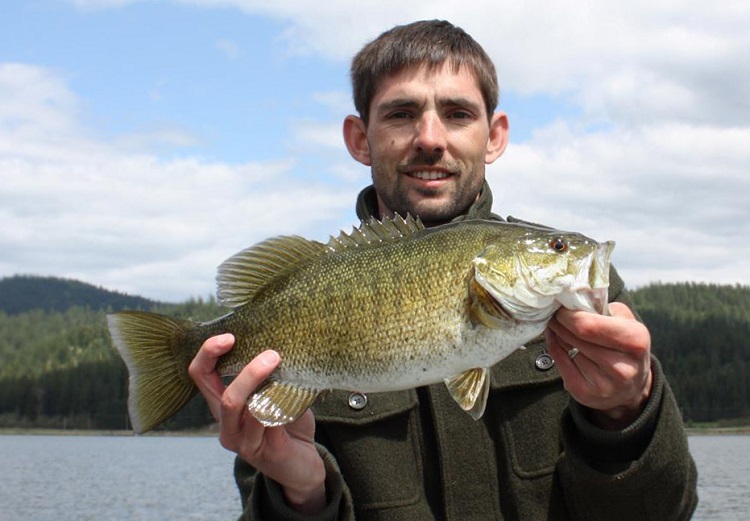

Jerkbaits have long been known for cold, clear water fishing conditions. To bass anglers, these baits are often utilized with aggressive retrieves that force fish into biting. While many anglers focus on the cadence, the dominant slashbait artist pays attention to something a bit more hidden – the jerkbait’s available slack.
Deadsticking
Water in the high 30s or low 40s certainly calls for longer pauses. Cold water anglers often target smallmouth and largemouth with many of the same retrieves seen in the warmer months, but the time in-between the snap of your rod increases. Pauses of 1-minute or more are often deployed to target fish on or near structure. The area where many anglers fail with deadsticking is adapting to wind and boat movement. In early spring, the rise and fall of a boat’s bow can alter the pause of your bait. The remedy is to ensure you cut your jerkbait some slack and allow the bait to suspend as intended.
Secondly, water temperatures play a role in how jerkbaits perform. From adding split rings to increasing hook sizes, anglers have been accustomed to modifying their baits to ultimately increase performance of the suspending nature of their chosen baits. Deadsticking, or allowing the bait to sit still for a long period of time, is different with each and every lure choice. Knowledge of how each lure suspends in different water temperatures is just as important as allowing the bait to pause motionless by feeding your jerkbait slack.
Strikes and bites are seldom felt with this type of retrieve. By using light line, such as Seaguar’s 10-pound InvizX Fluorocarbon, anglers will have to keep a keen eye on the whereabouts of their line. A slight “tick” or “jump” of the line indicates a strike. Reeling down and applying taught pressure with the rod is much more forgiving than a swing when setting the hook. These fish often have the bait horizontal across the mouth, so a “reel down” approach can help keep it buttoned back to the boat.

Jerk, Jerk, Pause
This familiar one-liner is the cadence that most anglers begin with when searching for an active bite. But with failed results or slow fishing conditions, this particular cadence is the first and last to often hit the water. Much like other techniques, the jerkbait rarely receives its 15-second fame if catching conditions cease to exist.
The jerkbait’s most effective cadence is not the count at which you snap your rod, it is how you allow the bait to move with each and every snap. With a hard snap down, or to the side, the bait rips left or right in an unpredictable pattern. Much like walking a topwater lure from side to side, the same principal can be used to ensure proper action with jerkbaits. This school of thought almost instantly changes the way anglers approach jerkbait fishing, instantly increasing success on the water.
While the jerk, jerk, pause method still reigns king as a chosen favorite, the subtle difference of following through and pointing your rod tip back at the bait is the real secret to your fishing success. Each and every snap of the rod starts with the rod tip pointing at the lure and the finishing position should be no different. Rapala’s X-Rap series in colors Silver/Blue and River Perch are consistent performers in the northwest. There is no better teacher than buying a few select brands and seeing which performs best on your home lakes.

Slashbaiting
The nickname “slashbait” has been adopted by many jerkbait anglers by the way that they approach the technique. By being adaptive and experimental, West Coast anglers continue to see tremendous results by ripping their way through local lakes and reservoirs.
This particular retrieve involves a constant cadence and very little rest. Three snaps of the rod followed by a split-second of ease is repeated for a full out assault from the moment your lure enters the water. Smallmouth bass are ever more inclined to seek and destroy the jerkbait when it poses a serious challenge. This retrieve is also most effective in lakes and reservoirs that are home to ultra-clear water. One of my favorite baits for slashing is the Ima Flit 120 in Matte Bluegill.
As with all techniques, jerkbaits are best employed when used appropriately. The mechanics of each bait can be dissected much like other specialties throughout gear fishing – swimbaits, jigs, crankbaits and the list goes on and on. Much of an angler’s success weighs heavily on the choices made during a given trip. The greatest attribute of any jerkbait is its ability to be used as a search bait or as a target bait. More often than not, if you experiment with these three different cadences and allow the bait to work with each and every snap, active fish will show themselves and the areas that deserve more attention. A little slack in your approach can go a long way for greater success.


 Advertising
Advertising